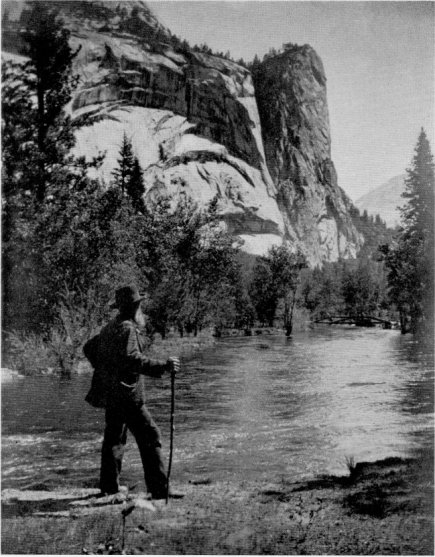
[click to enlarge]
John Muir, Washington Column. Yosemite
| Online Library: | Title | Author | California | Geology | History | Indians | Muir | Mountaineering | Nature | Management |
Yosemite > Library > François Matthes > John Muir and the Glacial Theory of Yosemite >
Next: Appendix: Geologic Time • Contents • Previous: Mount Whitney

[click to enlarge] John Muir, Washington Column. Yosemite |
John Muir’s name, it need hardly be said, will forever be associated with the Yosemite Valley which he loved so well. It will also be remembered—should be remembered—as the name of the humble nature lover who dared oppose the dictum of one of the foremost geologists of his time. The theory of that scientist, then widely accepted, was that the Yosemite had come into existence suddenly as the result of a violent convulsion of the earth, its bottom dropping out, so to speak, and leaving the sheer walls standing. Nothing but a catastrophic happening of this sort, it was believed, could have given the chasm its extraordinary shape. Yet Muir boldly advanced the unorthodox idea that the Yosemite had been gouged out primarily by a mighty glacier of the Ice Age, and that it had been elaborated little by little in the course of thousands of years.
In the controversy that ensued, Muir’s theory was treated rather roughly by his opponents. Scientific controversies in those days were not conducted in the gentlemanly manner that now prevails. His views were assailed, ridiculed, and belittled as the wild fantasies of an ignorant shepherd. It seems appropriate, then, on this occasion to show where Muir’s theory now stands, and to appraise its scientific worth as impartially and as dispassionately as may be, in the light of the findings of modern geologic research.
Mine was the privilege for several years, under the auspices of the United States Geological Survey, to study the complex problem of the Yosemite’s mode of origin. Systematically and in detail I covered the very ground that Muir studied with so much zest. I did so, however, without the guidance of the charmingly intimate accounts of his discoveries which Muir wrote in letters to his friends, for those letters then were not yet published. My findings, therefore, were independently arrived at. Moreover, they were tested out by comparative studies in all of the other Yosemite-like valleys of the Sierra Nevada.
The results may be summed up as follows: In neither the Yosemite nor in any other valley of its type is there evidence of any dislocation of the earth’s crust. In every one of these valleys, on the other hand, there is abundant proof of powerful glacial action such as Muir had recognized. To be sure, the glaciers did not reach down to the foothills, nor did they excavate the canyons in their entirety, as Muir supposed. The Ice Age, it is now clear, was preceded in the Sierra Nevada by long periods of canyon cutting by the streams in consequence of successive uplifts of the range. But let no one cite these recently determined facts to Muir’s discredit, for geologic science in the sixties and seventies of last century had not advanced to the point where any man, however expert, could have detected and proved them. Whatever shortcomings may be found today in Muir’s geologic interpretations, they are to be attributed primarily to the limitations of the science of his day. To one thoroughly at home in the geologic problems of the Yosemite region it is now certain, upon reading Muir’s letters and other writings, that he was more intimately familiar with the facts on the ground and was more nearly right in their interpretation, than any professional geologist of his time.*
On this centennial of his birth, then, it will be a source of satisfaction to his friends and admirers to learn that, far from being in error, Muir was probably as nearly right in his glacial theory of the Yosemite as any scientist in the early seventies could have been.
Written for a broadcast, April 17, 1938. Reprinted from Sierra Club Bulletin, 1938, pages 9-10.
*See especially, John Muir’s Studies in the Sierra. The Sierra Club, San Francisco, 1960. 142 pages. Introduction by William E. Colby; Foreword by John P. Buwalda.
Next: Appendix: Geologic Time • Contents • Previous: Mount Whitney
| Online Library: | Title | Author | California | Geology | History | Indians | Muir | Mountaineering | Nature | Management |
http://www.yosemite.ca.us/library/matthes/john_muir_glacial_theory.html